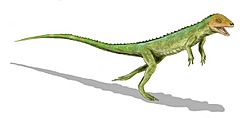Eudibamus facts for kids
Quick facts for kids EudibamusTemporal range: Early Permian
|
|
|---|---|
 |
|
| Life restoration of Eudibamus | |
| Scientific classification | |
| Kingdom: | |
| Phylum: | |
| Class: | |
| Subclass: | |
| Order: |
Captorhinida
|
| Family: |
Bolosauridae
|
| Genus: |
Eudibamus
|
| Species | |
|
|
Eudibamus was a small, two-legged reptile that lived about 290 million years ago during the early Permian period. Its name means "good two-footed one," which describes how it moved. Scientists found its fossils in Germany. This ancient creature is very special because it might have been the first vertebrate (an animal with a backbone) to walk on two legs.
Contents
Meet Eudibamus: The Two-Legged Reptile
Eudibamus was a type of reptile called a bolosaurid. It was quite small, probably only about 10 inches (25 centimeters) long. Imagine a lizard about the size of a small house cat, but much older! Its body was built for speed and agility.
Scientists believe Eudibamus walked on its two back legs, much like a human or a bird does today. This way of moving is called bipedalism. It's rare for such an ancient reptile to be bipedal, which makes Eudibamus a very important discovery.
How Did Eudibamus Walk?
When scientists studied the fossil of Eudibamus, they noticed some interesting things about its legs. Its back legs were longer and stronger than its front legs. This suggests it used its back legs for walking and running.
Its tail was also long and thick. This long tail likely helped Eudibamus balance itself while it ran on two legs. Think of a kangaroo using its tail to balance! Walking on two legs could have helped Eudibamus run faster to catch food or escape from bigger predators. It might also have helped it see over tall plants.
What Was the Permian Period Like?
Eudibamus lived during the early Permian period, a time long before dinosaurs roamed the Earth. The world looked very different back then. All the continents were joined together in one giant landmass called Pangaea.
The climate varied, with some areas being very dry and others having large forests. Many different types of ancient reptiles, amphibians, and insects lived during this time. Eudibamus shared its world with other early reptiles and creatures that are now extinct.
Discovering Eudibamus Fossils
The only known fossil of Eudibamus was found in a place called the Bromacker quarry in Thuringia, Germany. This quarry is famous for its well-preserved fossils from the early Permian period.
When scientists find fossils, they carefully dig them out of the rock. Then, they clean and study them to learn about the ancient animals. By looking at the bones of Eudibamus, they could figure out its size, how it moved, and what kind of animal it was. The discovery of Eudibamus helped scientists understand more about how animals started to walk on two legs.

